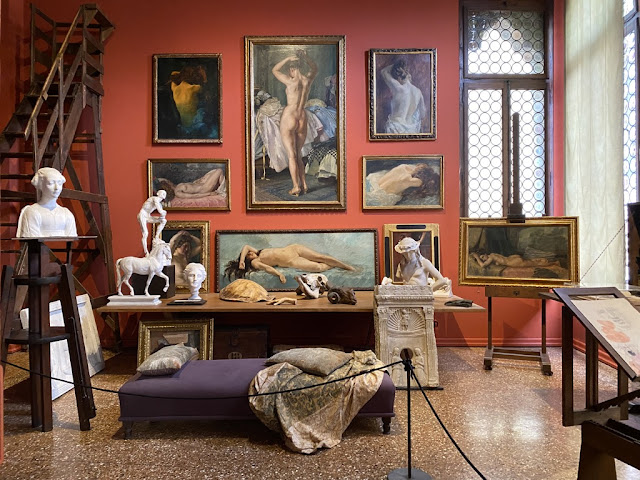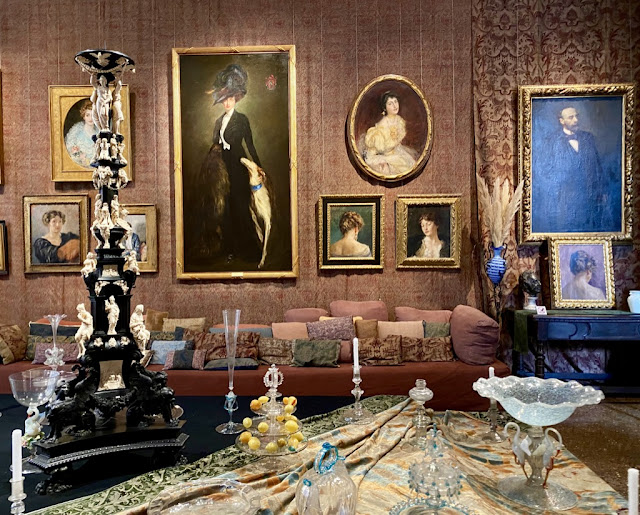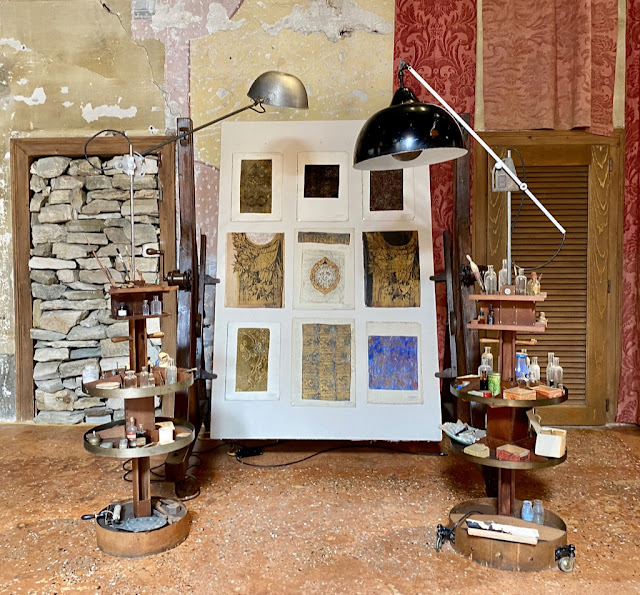The Reopening
Palazzo Fortuny - House Museum
The Venetian Gothic, Palazzo Pesaro dei Orfei, better know as Palazzo Fortuny, that was the home and workshop of Mariano Fortuny y Madrazo - Granada 1871, Venice 1949 - and his wife, muse and companion Henriette Nigrin was a focal
point, at the beginning of the 20th century, for the European intellectual elite and a productive
centre in cosmopolitan, hardworking Venice. It now reopened its doors following essential
conservation work on the ground floor - seriously damaged by the Acqua Granda in November
2019 - and the complete refurbishment of the piano nobile. It is no longer just a space for temporary
exhibitions but also the house museum to the permanent collections of Mariano Fortuny, his
universe of light and innovations.The exhibits include paintings, lighting systems, clothes, fabrics, colours and dyes resulting from the genius of Mariano and Henriette, together with photographic archives and items from their personal collection, documents and patents, and works by artists and friends who came to Venice and lived in and found new light in the palazzo overlooking Campo San Beneto. The museum's layout was designed by Pier Luigi Pizzi with Gabriella Belli, Chiara Squarchina and lighting by Massimo Gasparon and revokes the atmosphere of one of the city's most iconic palazzi.
https://fortuny.visitmuve.it/en/home/
The Portego
Spanish Heritage
The portego area looking towards Campo San Beneto expresses the full force and energy of
Mariano Fortuny’s Spanish heritage thanks to the furnishings and the copies from
Goya, an artist who Fortuny learnt to love from a very young age thanks to his maternal
grandfather Federico de Madrazo y Kuntz, the director of the Prado Museum. The
celebrated portrait of Fortuny’s sister, Maria Luisa Fortuny y Madrazo – above left - a grim and thin
female figure who was with her brother for much of his time in Venice.
Mariano Fortuny y Madrazo received an international upbringing, having been born into one
of the best-known families in 19th-century Spanish artistic and cultural life. He was a multifaceted, eclectic and tireless artist; a talented genius receptive to modernity and the
innovations of the 20th century; and an astute businessman capable of applying his creativity
to various artistic disciplines, including painting, sculpture, printmaking, photography,
theatre, lighting, design, fashion and textiles for furnishings – Mariano Fortuny was all of that
and more. He invented production processes, created new materials, designed technical
devices for which he took out trademarks and patents. And it is this world, a mix of influences,
ideas and materials, that is coming to life now in the new layout of the museum in the Palazzo
Fortuny. The building was donated to the city council in 1956 by Fortuny’s widow Henriette, so that it might be perpetually used as a “centre for culture relating to art”, preserving in the
first-floor reception rooms the characteristics and the objects “of what was Mariano’s favourite
studio.
Mariano Fortuny - self-portrait - undated - tempera on cardboard
The Fortuny Atelier
In Mariano Fortuny’s
studio which is illuminated by three Gothic windows, on show are a series of nude paintings, copies of statutes, preparatory canvasses and a self-portrait. Painting
always played a primary role in the life of the eclectic artist. The nude for Fortuny was a fundamental exercise in order to assimilate
classical lessons through studies of anatomy. For him painting was the most important means of discovering innovative
solutions that were useful in the disciplines in which he was a master, such as
scenography, photography and printing on fabric.
Sketch for the Four Elements - Water
undated - tempera on paper pasted on cardboard
Sketch for the Four Elements - Fire
undated - tempera on paper pasted on cardboard
Belvedere Torso
copy after Apollonios Athenian - undated - gypsum
The Winter Garden
The Winter Garden is a work that Mariano Fortuny planned
and created, for which he invented a special framework of paper glued
onto hemp cloth painted and attached to the walls. Supported by the artifice of
the trompe l’œil and by a harmonious application of colours, the
creation gives the space great luminosity. It is an ideal “enchanted garden'
animated by allegorical figures, satyrs and exotic animals: all set in a Veronese-style Corinthian loggia, embellished by luxuriant plant motifs,
verdant garlands and sophisticated drapes. In the centre of the room two
environments are formed in ideal terms.
“I
discovered and studied Mariano Fortuny while attending the faculty of
architecture at the Polytechnic University of Milan, having already decided I
wanted to work in the theatre. His experiences as a set, costume and
revolutionary lighting designer for Wagnerian theatre at Bayreuth and at the
Scala had fascinated me. When I made my debut at the Fenice I found myself
using his famous Dome light. Later, a reading of Proust’s In Search of Lost
Time revealed to me another aspect of the versatile artistic practice of
Fortuny, who created textiles inspired by the Venetian paintings of Carpaccio
and era-defining fashion garments.”
Pier Luigi Pizzi
architect, director, set designer
Pier Luigi Pizzi
architect, director, set designer
exhibition designer
Teatro delle Feste - template - cavea - undated- Gypsum -wood - fabric
The Winter Garden
In
the second part of the Winter Garden we find the model for the Teatro delle Feste designed
by Mariano Fortuny in 1910 in collaboration with Gabriele d’Annunzio and the
French architect Lucien Hesse. An authentic synthesis of his theatrical
poetics. The project, which was never realised, was to be positioned on the
Esplanade des Invalides thanks to the economic support of two of the best known
and richest personalities in the France of the period: Baron Maurice de
Rothschild and Senator Deutsch de la Meurthe, added to whom would be the
entrepreneur Jose Schurmann.
The Portego
Along
the immense portego, discreetly lit by the marvellous polifora windows we find a succession of fantastic textiles, highly original lamps inspired by planets, and of Fortuny's own design, pictures, furniture and objects – as documented in
period photos – Mariano’s Spanish origins and the intellectual and artistic
world of the Madrazo and Marsal families are recalled. There is space too for
the pictorial output of both the artist and his father – a fine painter who
produced a series of small landscapes on view in a large wardrobe-display
cabinet - see below - designed by Mariano – interspersed with portraits and works inspired by
Henriette that focus on her face, hair and poses.
works by
Mariano Fortuny y Marsal
Funeral Attire
There are amazing and dramatically
striking pairings of fabulous, printed velvets created by Mariano, with motifs
inspired largely by the Renaissance; the original model of the attire he
designed for the funeral of the fourteenth duke of Lerma - see above - who died in the
Spanish Civil War, of which an exceptional dalmatic in gold and silver printed
black velvet stands out; and Mariano’s stage costumes for a production of
Giuseppe Verdi’s Otello. The opera was performed by Kiki Palmer’s
company in the courtyard of the Palazzo Ducale on 18 August 1933, with set and
costumes by Fortuny and the direction of Pietro Sharoff.
Friends and Loved Ones
In this part of the portego, a sort of family living room, lined up along the walls are sofas with
soft cushions covered in the well-known Fortuny Fabrics, recognizable by the
eclectic taste that shaped an output inspired in equal measure by the
Renaissance and Oriental curiosities, as
well as, a number of portraits of his wife Henriette Nigrin signed by him and some realised for the Venice Biennale of Art. Also along the walls are works by other artists, such as the Portrait of Riccardo Selvatico
by Alessandro Milesi or Aunt Luisa by Ignacio Zuloaga and
the full-figure portrait of Contessa Anna Morosini by Lino Selvatico -
above center. Between 1899 and 1942 Fortuny was to participate in eleven
editions of the Venice Biennale with his paintings, indeed, after his
death, a retrospective exhibition would be devoted to him in 1950.
“Antique printed
textile fragments found in Greece gave me the idea of studying a number of
techniques for printing on cloth, so my wife and I established a studio in
Palazzo Orfei for printing using our methods."
Mariano Fortuny
Fortuny Style
It
was in fashion and in fabrics that Mariano Fortuny expressed his highest
creative vein and in 1907 this passion of his was translated into a fully-fledged
activity. In Berlin, in
1907 Mariano presented the printed silk shawl Knossos, worn for the
occasion by Ruth St. Denis, an American ballerina and choreographer, a
pioneer of modern dance. This silk rectangle, almost five metres long and a
little more than a metre wide, characterised by decorative motifs in an Minoan
style, was printed using Fortuny’s unprecedented printing system. In 1909 and 1910
Fortuny patented two printing techniques and realised one of his best known
creations: the Delphos, a simple and essential shaped silk gown,
inspired by Greek statuary. Coming about from an idea of Henriette, the gown is
presented as a monochrome tunic characterised by extremely fine pleating.
Mariano Fortuny - Knossos Scarves and Delphos Dresses
modern print photograph from original gelatin - 1910c.
The Wagner Room
The
four side rooms of the piano nobile of the house museum - not documented in the
Fortuny archive - have been laid out with a more specific museum function. Here
visitors can admire the eclecticism and brilliance that Mariano Fortuny
displayed in the world of fashion; in his enduring interest in studying the
ancients, Tintoretto, Tiepolo, Rubens; in armoury, a passion
inherited from his father; in his love for the opera of Wagner – above - and, once again, in his fine work as a
painter, documented in the studio where, among casts of ancient sculptures,
sketches for stage sets and nude portraits, his working environment has been
reconstructed with easels, palettes and the colours he patented in Paris in
1933.
The Second Floor
On the
second floor - accessible in the next few months - are Mariano’s studios, revealing all his abilities,
skills and arts – a ‘behind the scenes’ of his creations. There is the
printmaking and typography, with presses, etchings, his own productions and the
equally fine ones of his father, and the works collected by the family, for
instance etchings by Goya, Tiepolo and Piranesi. Then there is the textile
laboratory of gowns and fabrics, including his mother Cecilia de madrazo y Garreta's important collection of
garments and ancient fabrics, the original matrices for printing and models for
pattern cutting; the theatre, with the wooden stages made by Mariano to try out
lighting and stage effects. Alongside this is the photographic studio, with the
experimental equipment that led to the patenting of a special kind of photo
paper, and finally, his work as a painter and his beloved books. Even Mariano’s
study and library, immortalized in many photos from the period, will be open to
the public for the first time.
Family collection of Ancient Textiles, belonged to Cecilia de Madrazo y Garreta
Fondazione di Venezia Collection - on loan from Museum of Palazzo Mocenigo
The core of Mariano Fortuny's photographs collected at Palazzo Fortuny
are taken from either the collection left by Mariano
Fortuny or from the rich collection of the Musei Civici
di Venezia. The entire collection comprises works from 1850 to
the Second World War, with a rich variety of styles,
techniques and historic images. In this room we find modern prints from original negatives by Mariano and Henriette Fortuny
Mariano Fortuny Photographer
As a photographer, Mariano Fortuny is in many ways
different to the retiring star of fashion and art.
Though even here one can see his command of the
medium and his capacity to move the viewer, there is
no doubt that Fortuny neither was – nor aimed to be – a
professional photographer; as is well known, he used the
camera mainly as an tool for his work as a scenographer
and textile designer. Nevertheless, even here he
inevitably reveals his eye as an artist: in the private
shots and the pictures taken as an aide-memoire, he
certainly achieved results that bear comparison with
those of the more famous photographers amongst his
contemporaries.
The photographs of Mariano collected at Palazzo
Fortuny, show family groups, friends and the famous
celebrities who formed part of Fortuny’s social circle,
travel notes, interior shots, self-portraits and images of the less well known corners of Venice.
Mariano Fortuny
with one of his cameras - see below - anonymous - 1890 c.
Mariano Fortuny - Marchesa Luisa Casati - 1913
the first celebrity to purchase a Delphos dress in 1909
Photography and lights
In 1931 Fortuny went to Paris to file a patent for a photographic paper with coal-tar
pigments of his invention. Two years later he marketed the Tempera Fortuny, the colours he
had created and used since the beginning of his painting activity. Their technical
characteristics and quality would be enhanced by a publication by Rene Piot. In 1937 Fortuny devoted himself again to the
lighting systems on the occasion of the great exhibition on Tintoretto in
Venice: his lamps with indirect and diffused light illuminated the rooms of the
Scuola Grande di San Rocco.
Easels for Painters and Restorers - patented by Mariano Fortuny - 1933.
Fabric Printing Samples - early 20th century
The Private Library
close-up
Fortuny’s private library, which is immortalized in many photos from the period, will
be open to the public for the first time in the next few months – the room is a fascinating discovery featuring
the furniture he designed, the books and scrapbooks, the cuttings and the curiosities he kept, the
covered filing cabinets and his most personal mementoes.
Archivist of the Fortuny Museum, Cristina Da Roit, Maestro Pier Luigi Pizzi and director of the Fortuny Museum, Chiara Squarchina
The exhibition layout of the Fortuny Museum was designed by Maestro Pier Luigi Pizzi with Gabriella Belli, Chiara Squarchina and lighting by Massimo Gasparon.























